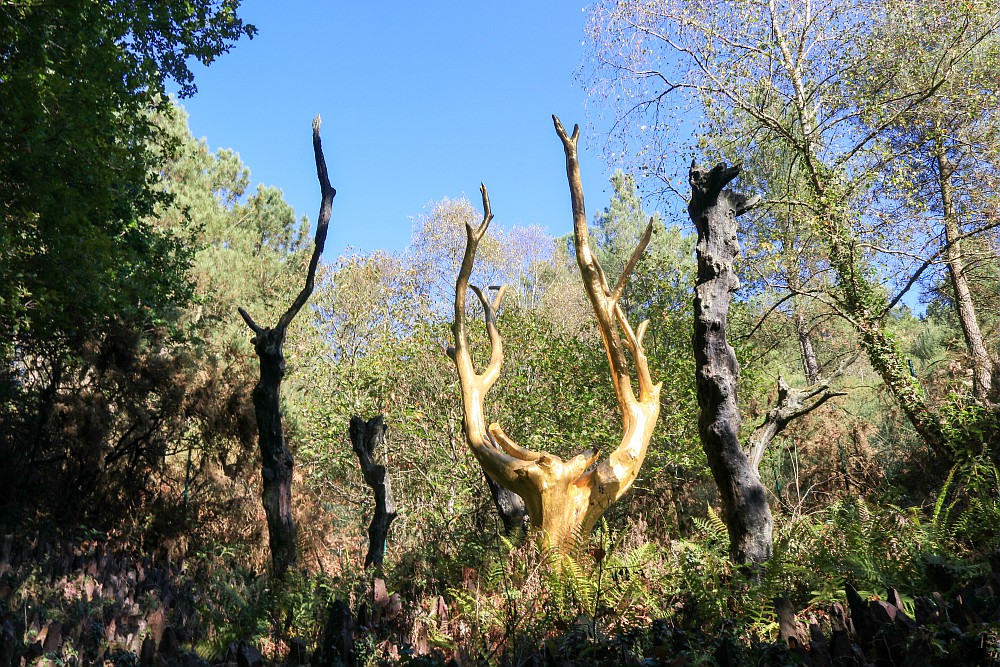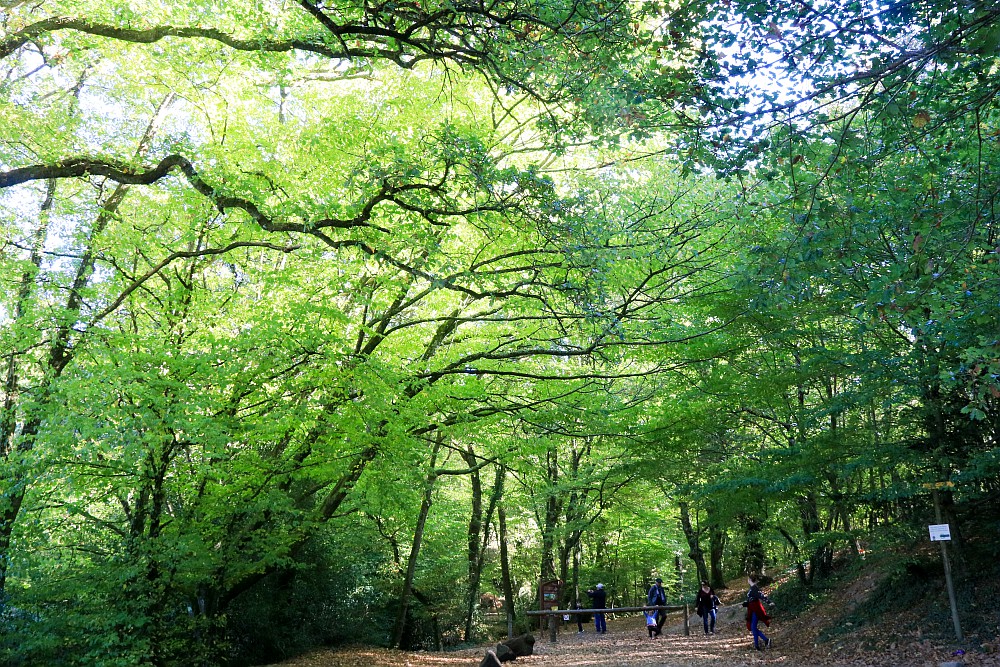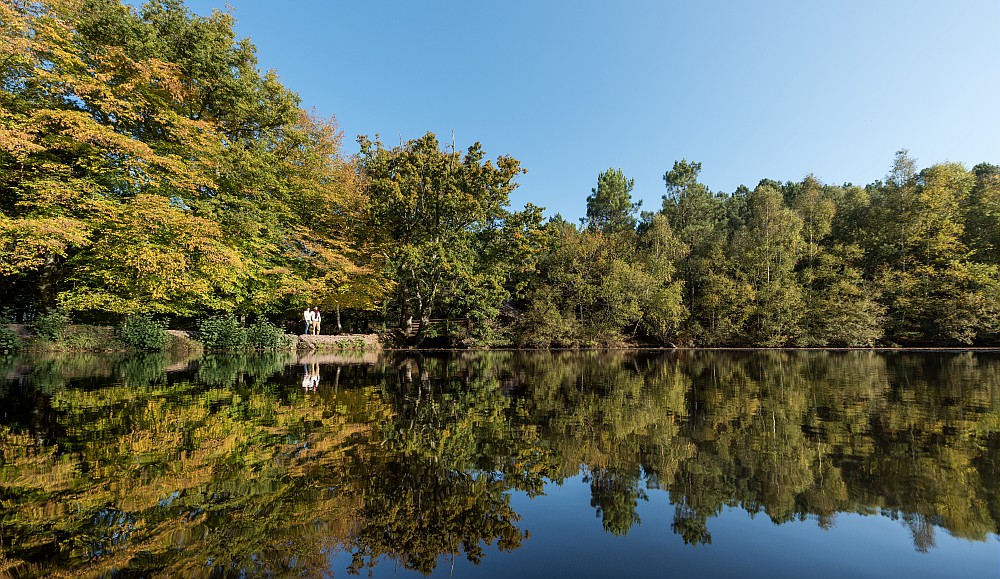
Brocéliande is one of the magical places in Brittany. Anyone who has ever walked through the forest near Paimpont will understand why many stories and legends relating to the Arthurian legend are set among the mysterious trees. Some are purely mythical, such as the prison of the fairy Morgane or the lake where the knight Lancelot grew up. Other story-telling locations take on a concrete form. These include the tomb of the wizard Merlin, which is actually a megalithic site, or the “Fontaine de Barenton” in the heart of the forest.
The charm of Brocéliande still lies in the fact that the area, the size of Paris, is not overrun by crowds. On the contrary, those in search of peace and seclusion will find it in many parts of Brocéliande.
Discover now:
- Le Tombeau de Merlin l’Enchanteur
- Le chêne des Hindrés
- La fontaine de Barenton
- Jardin aux Moines
- Val sans retour
- Château de Trécesson
Hiking through the forest

If you were to walk to the sights presented here one after the other in the order described, it would take over 8 hours to walk between the first stop, “Merlin’s Tomb”, and the castle of Trécesson. The extent of a tour through the forest therefore depends above all on physical fitness. In any case, it is more relaxing to pick out individual stages and plan enough time to enjoy the magnificent forest and heath landscape.
Whether short or long – a hike through the forest should be well prepared. Provisions belong in the rucksack, as does any rubbish that may be left after the picnic. Some of the forest’s sights are a good distance from the nearest car park. Suitable footwear is therefore a must – especially if the ground is soggy after a Breton downpour.
Take at least a day and let the place work its magic on you. .
Le Tombeau de Merlin l’Enchanteur
The wizard Merlin is one of the most famous and mysterious figures in the cycle of legends about the knights and fairies of Brittany. Son of the devil and a pure girl, Merlin is a mixture of human and supernatural being. His creators develop the character over time and writing into a master of metamorphoses: druid, prophet, sorcerer, soothsayer, scientist and healer. In his most important role, he is confidant and advisor to King Arthur.
People of all times have been fascinated by Merlin. In the 19th century, local intellectuals are said to have found his grave here in Brocéliande. But can a character like Merlin die at all? In legend, it would be love that removed Merlin from the face of the earth forever: according to the legend, the fairy Viviane, who wanted to preserve Merlin’s love forever, locked her lover in an ethereal prison high up in the clouds.
Back to reality: before the site of Merlin’s tomb was partially destroyed in the 19th century, the monument was a megalithic burial site. Visitors at the time saw a 12-metre-long Neolithic alley covered with red slate. Today, only two megaliths remain. Two stones leaning against each other and thus inspiring the imagination. For are they perhaps more than two stones after all, namely two lovers forever entranced under the trees of the forest? Who knows for sure …
“Merlin’s Tomb” is located about 20 minutes walk away from the oak of Hindrés, the nearest town being Saint-Malon-sur-Mel. The sight is not recommended during the hunting season from 1 October to 31 March on weekdays Monday, Tuesday and Saturday.
Le chêne des Hindrés
The Hindrés oak, is one of the largest representatives of its species in the Paimpont forest. What makes the oak interesting is its age of 500 years and its strangely shaped branches, which fan out at an airy height in an ornate manner.
Despite being located in the heart of the Brocéliande forest, the tree is easily accessible – even for visitors with limited mobility. Unless the ground is soggy after long rains.
The nearest larger village is Saint-Malon-sur-Mel. On foot, it would be a hike of a good 3 kilometres from there, or about 45 minutes marching south, always on the narrow D59. Getting there by car is more comfortable, especially as there is a car park near the protected natural monument and the path is signposted from there.
La fontaine de Barenton
Near the village of Folle Pensée, in the heart of Brocéliande, is the natural and magical water spring of Barenton. Robert Wace, a Norman poet and scholar of the 12th century, first mentioned the spring under the name of Berrenton. The name is composed of the Indo-European word for “boil” and the Celtic “andon” for “spring”.
At the same time, Chrétien de Troyes depicts the fountain in his verse novel “Yvain or the Lion Knight”. In it, when the hero Yvain arrives in Barenton, he seizes the golden basin hanging from a pine branch, plunges it into the well and pours water onto the steps. Immediately the blue sky darkens, rain falls on the forest and lightning drives out of the sky. After a few terrifying minutes, the storm finally stops. The black knight, guardian of the well, storms out at a gallop. A terrible battle breaks out – which Yvain decides in his favour after a long struggle.
Even today, the spring is said to have magical powers. It is said that thunder and lightning come when water pours down the steps. The water is also said to cure madness, a property that earned the nearby village its name Folle Pensée.
Finally, a visit to the fountain is recommended for those in love and looking to get married. According to legend, the fountain requires a pin to be thrown into the water with the accompanying words: “Stand up, fountain, I’ll give you a beautiful pin”. If the fountain starts bubbling, the wedding bells will ring before Easter!
From the nearest car park in the village of Folle Pensée, it is a 20-minute walk to the Fontaine Barenton.
Jardin aux Moines
On the D141 road north of Tréhorenteuc is the “Jardin aux Moines” – the garden of the monks. The northern side of the site, uncovered in 1980, is described by 27 megaliths, its southern side by 26 stones. Archaeologists attest that the Jardin aux Moines has a long history as a burial site, with the oldest chambers dating back to 3,000 BC.
The megaliths are made of quartz and local red slate. Depending on the incidence of daylight, the stones therefore shimmer in different colour variations.
Val sans retour

In the myth cycle around King Arthur, the “Valley of No Return” is an enchanted land. The sorceress Morgan le Fay holds her lovers captive here until the spell is finally broken by the knight Lancelot. To be imprisoned is a good keyword considering the beauty of this spot on earth, but today the forest only attracts visitors with its many attractions in a small space. You want to be sure to enjoy the attractions undisturbed? Then we recommend a visit outside the main season or in the early hours of the morning, when the mist and the voices of the birds perfect the magical atmosphere.
The real Val sans retour can be found not far from the village of Tréhorenteuc. The best place to start a tour is the free “Vals sans Retour” car park on the edge of the village. From there it is a good 5 minutes to the first sight of the valley, the “Miroir aux fées”. On the way there, you cross the border between the departments of Morbihan and Ille-et-Vilaine. The “fairy mirror” is almost always a mirror-like pond because of the density of the forest surrounding it, which prevents the wind from stirring up the water in it.
Val sans retour – Part 2
A stone’s throw from the shore of the lake on the north-western side stands the “Arbre d’Or”, the gilded tree forming an installation with 5 charred chestnuts. The symbolism of this work of art in the open air is complex. It is important to know that a forest fire raged in Brocéliande in 1990. Large parts of the tree population fell victim to the flames, which the black trunks are supposed to remind us of.
At the same time, the event triggered a wave of donations and thus facilitated reforestation. The artist Francois Davin felt inspired and wanted to do his part with a symbol of fertility and eternity. The tree’s branches are reminiscent of the antlers of Cernunnos, the deer-headed Celtic god of nature, and pay homage to the region’s heritage and supernatural powers. This is how the Arbre d’Or came to be one of Brocéliande’s most famous photo motifs.
About a 5-minute walk and a few metres up from the Golden Tree is the “Siège de Merlin” – Merlin’s Chair. The rock is an eroded cliff overlooking the heath and woodland of the Val sans retour. According to legend, the wizard Merlin sat here to meditate and guard the valley. In the fire of 1990, the rock suffered: the heat generated was so enormous that the rock almost cracked in many places.
At just under 3 kilometres and about 40 minutes from the Siège de Merlin, still within walking distance, is “Hotié de Viviane” – the House of Viviane, also called the “Tomb of the Druids”. The mythical refuge of the fairy Viviane is a megalith made of red-coloured slate slabs, dated between 3,355 and 2,890 BC.
Tombeau des géants
Excavation of this megalithic monument in 1982 revealed a wedge structure around the Bronze Age tomb, almost 4 m long, 1 m wide and 1 m high. The tomb consists of three menhirs that stood at this site around 2,200 years BC. Another menhir lies about 8 metres away. The stone probably belongs to a series of megalithic sites from the Bronze Age around 1500 BC.
Château de Trécesson
Trécesson Castle stands on the southern edge of the Brocéliande forest. Surrounded by a moat, the Château is an impressive example of 15th century feudal architecture and is one of the most beautiful castles in Brocéliande, if not in all of Brittany. The castle has nothing to do with figures such as Merlin, Lancelot and Morgane, but instead has its very own (horror) tales entwined around it. One of the best known is that of the “Dame Blanche”, the White Lady. The ghost is the revenant of a young lady buried alive not far from the castle and is said to appear on the roofs of the castle on full moon nights.
The nearest village is Campénéac. The castle is privately owned and only open to visitors on a few days a year. Unfortunately, you only find out which days on site. Nevertheless, it is worth a trip, if only for the wonderful surroundings.
Fotos: Comité Régional du Tourisme de Bretagne | © Yanick Le Gal, © Emmanuel Berthier, © Donatienne Guillaudeau, © Yannick Derennes, © Ronan Gladu, © Jacqueline Piriou, © Loic Kersuzan
